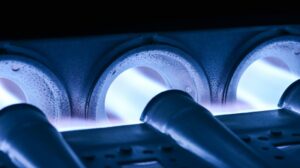More than 64 million homes in the US use natural gas to heat their houses, and most of these homes use a furnace for the job. It’s no surprise that gas furnaces are the popular option for keeping cozy in the winter. They produce heat faster than electric ones, and do it quickly, efficiently, and economically.
Although gas furnaces are built to be as safe as possible, there are potential hazards. If you’re using a gas furnace to heat your home, it’s imperative to be aware of the things that could go wrong. One of these potential problems is a cracked heat exchanger. This is not a minor repair by any means. While gas furnaces do have a special feature to turn the system off if something malfunctions, a cracked furnace heat exchanger can be subtle and dangerous.
Why Is a Cracked Heat Exchanger a Serious Problem?
The reason a crack in a heat exchanger poses serious problems is that it creates a major health hazard. To understand why, you need to know a bit about how a heat exchanger functions.
Designed in a clamshell shape, the heat exchanger is a metal container that collects hot combustion gas from the burners. The heat from the gas transfers to the metal walls, causing the exchanger to burn hot. Air from the blower moves around the exchanger and picks up the heat before it passes into the ventilation system. The remaining combustion exhaust in the exchanger is then sent through a flue to escape to the outside air.
If this essential component of your furnace has cracks, the toxic combustion gases could potentially enter the air being blown into the rooms. This is a huge health concern!
What Causes Heat Exchangers to Crack?
The heat exchanger’s metal chambers expand and contract as they heat and cool. Eventually, this strain can cause a crack to form. Corrosion can also weaken the metal until it cracks. This is usually due to the reaction between the combustion gases and the metal.
How Do I Know If My Heat Exchangers Are Cracked?
Unfortunately, these cracks are incredibly small and nearly invisible to the naked eye. Here are some signs of a cracked heat exchanger that you should be on the lookout for.
- Your carbon monoxide detector is going off
- You or any household members have had frequent headaches or flu-like symptoms
- Your furnace isn’t producing heat
- A clicking noise coming from your furnace soon after the blower shuts off could be caused by the metal walls of the heat exchanger contracting back into place and the crack closing
- There are signs of visible corrosion anywhere on your furnace
It’s important to keep up with maintenance to avoid this potential safety hazard. Although older furnaces are more likely to develop cracks in the heat exchanger, keeping up on maintenance every year can help avoid this problem or catch it early, no matter the age of your gas furnace.
There’s no need to keep googling “furnace repair near me.” For professional and reliable furnace repair in our area, contact Brown’s Heating & Cooling.

